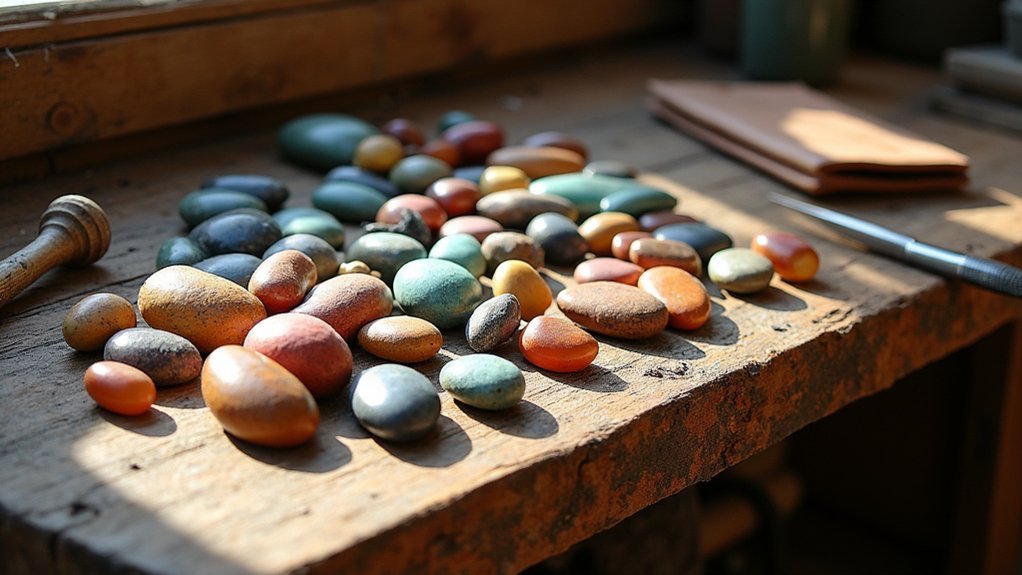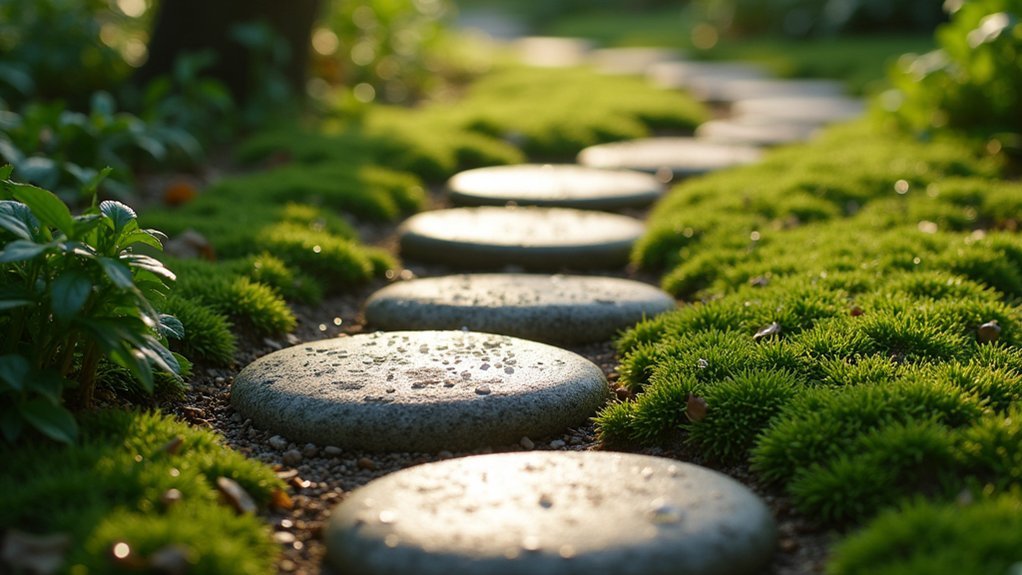You can master flush stone setting with basic tools costing under $100, developing superior hand skills and precision that expensive machinery can’t replicate. Manual tools like burnishers, gravers, and simple drills enhance your tactile sensitivity and problem-solving abilities while building fundamental techniques. Practicing on inexpensive materials like copper reduces financial risk as you gain confidence. This hands-on approach creates a stronger foundation than relying solely on automated equipment, preparing you for advanced techniques ahead.
Cost-Effective Learning for Beginning Stone Setters

While professional stone-setting equipment can cost thousands of dollars, you can master flush setting techniques using basic tools that won’t break your budget.
Beginning stone setters benefit from this cost-effective approach to jewelry making, using accessible tools like hand drills, simple burs, and burnishers instead of expensive machinery.
Accessible hand tools like drills, burs, and burnishers offer beginning jewelers an affordable alternative to expensive professional stone-setting machinery.
You’ll develop essential skills by practicing on affordable materials such as copper or inexpensive gemstones, reducing financial risk while learning.
Basic tools including pushers and needle files prove surprisingly effective for flush setting when paired with proper technique.
Free learning resources like online tutorials and community workshops support your skill development journey.
This affordable path lets you experiment and gain hands-on experience, building the precision and confidence necessary for advanced stone setting without the substantial upfront investment.
Developing Hand Skills and Precision Without Machinery
You’ll discover that mastering manual tools like burnishers and gravers becomes the foundation for precise flush stone setting when you can’t rely on machinery.
Your fingers will develop enhanced tactile sensitivity through consistent practice, allowing you to feel minute adjustments in metal and stone positioning that machines can’t detect.
This hands-on approach builds essential problem-solving adaptability skills, enabling you to work through unexpected challenges and achieve professional results with basic equipment.
Manual Tool Mastery
Before expensive machinery enters your workshop, developing exceptional hand skills with basic tools forms the foundation of professional flush setting. Mastering burnishers, gravers, and hand drills gives you precision and control that machinery can’t replicate. You’ll enhance your craftsmanship while building essential manual dexterity.
| Tool | Primary Function | Skill Development |
|---|---|---|
| Burnisher | Smoothing metal edges | Pressure control |
| Graver | Creating stone seats | Angle precision |
| Hand drill | Hole preparation | Steady movement |
| Ball vise | Workpiece stability | Enhanced visibility |
Practice on scrap metal develops your technique without costly mistakes. Start with copper—its softness allows easier adjustments while you learn proper angles and pressure. Regular practice helps you secure stones effectively, creating perfectly fitted stone seats that hold gems snugly without damage.
Enhanced Tactile Sensitivity
Since your fingers become your primary instruments when setting stones manually, developing enhanced tactile sensitivity transforms how you perceive subtle changes in metal resistance and stone positioning.
This heightened awareness allows you to detect variations in metal hardness and adjust your approach accordingly. Manual techniques sharpen your hand-eye coordination while teaching you to feel the precise relationship between stones diameter and seat dimensions.
Enhanced tactile sensitivity provides these critical advantages:
- Feel subtle metal resistance changes during seat preparation
- Detect ideal stone positioning through fingertip pressure
- Recognize when flush setting alignment achieves perfect precision
- Sense varying metal hardness properties across different jewelry design materials
- Identify problems before they compromise the setting quality
This refined sensitivity strengthens your problem-solving skills, enabling you to address challenges through touch rather than relying solely on visual assessment.
Problem-Solving Adaptability Skills
Manual flush stone setting demands adaptability when challenges arise, and your refined tactile awareness becomes the foundation for developing versatile problem-solving skills. When stones fit poorly, you’ll learn to modify seats and adjust the metal surrounding the stone through careful burnisher work.
| Challenge | Solution |
|---|---|
| Oversized stones | File seats gradually |
| Undersized gaps | Compress metal inward |
| Irregular shapes | Custom-form seat contours |
| Uneven surfaces | Level with precise filing |
Regular practice on scrap metal enhances your adaptability to different stone shapes and sizes. You’ll develop precision and control when manipulating small stones, learning to work around irregularities in the setting process. Visual aids like magnifying glasses improve your ability to assess problems quickly, while simple tools enable creative solutions for challenging flush settings.
Creative Problem-Solving With Household and Basic Tools
You don’t need expensive equipment to achieve professional-quality flush stone settings when you think creatively about everyday items around your home.
A simple drill or Dremel can replace costly specialized tools for creating pilot holes, while common household items like butter knives work surprisingly well for burnishing stone edges.
Your smartphone’s camera zoom function and basic measuring tools can provide the precision you need to execute clean, accurate settings without investing in professional-grade equipment.
Alternative Drilling Methods
When professional drilling equipment isn’t available, resourceful jewelers can achieve precise flush stone settings using common household and workshop tools.
Your flush setting begins with selecting the right household tools for drilling a hole accurately. A Dremel rotary tool works excellently for creating initial openings, while a handheld drill with a small drill bit enables precise pilot hole creation. Making informed decisions about tool selection guarantees you distribute pressure evenly across durable stones during installation.
- Create a makeshift drilling guide using wood blocks or sturdy cardboard for stability
- Use a pin vise for better control when manipulating small drill bits
- Employ a Dremel rotary tool for initial hole creation in metal surfaces
- Utilize a flex shaft with various burs for creative drilling and shaping techniques
- Make pilot holes with handheld drills before final stone placement
Improvised Burnishing Techniques
After creating your pilot hole, burnishing the metal around your stone requires creative adaptation of everyday tools to achieve professional results. You can perform improvised burnishing using the back of a spoon or small metal rod, applying steady pressure around the stone’s girdle for a secure fit.
Transform a broken bur bit into an effective burnisher by attaching it to a pin vise, creating cost-effective tools for your setting process.
Flat-ended screwdrivers work excellently for packing metal around flush set stones, while tweezers provide precision when maneuvering small stones into position.
For enhanced accuracy, use a magnifying glass or smartphone camera to inspect your work closely. These common household items can deliver surprisingly professional results when setting stones, proving that creativity often trumps expensive specialized tools.
Household Measurement Solutions
Accurate measurements form the foundation of successful flush stone setting, and most households contain surprisingly effective tools for this critical task.
You’ll find that measuring tapes, rulers, and calipers provide precise stone dimensions needed for drilling accurate pilot holes. Your household drill becomes a valuable asset when paired with correct burr sizes for creating clean openings.
- Use measuring tapes or rulers to determine exact stone dimensions before drilling
- Create a sturdy work surface with wooden tables or countertops for stability
- Secure jewelry pieces with rubber bands or small clamps to hold them securely in place
- Employ a magnifying glass or smartphone camera for enhanced detail visibility
- Match drill burr sizes to your measurements for precise hole creation
These accessible household tools transform setting stones from professional-only work into achievable home projects.
Understanding the Fundamentals Before Investing in Equipment
Before you invest in expensive professional equipment, you’ll benefit tremendously from mastering the core principles of flush setting through hands-on practice with basic tools. Understanding stone measurement and seat creation builds your foundation for future success. When you practice burnishing techniques with affordable materials like copper, you’ll develop muscle memory without risking expensive gems.
| Fundamental Skill | Practice Benefit |
|---|---|
| Stone measurement precision | Prevents costly mistakes |
| Seat creation accuracy | Guarantees secure stone fit |
| Ball bur techniques | Develops tool control |
| Burnishing methods | Masters finishing skills |
| Troubleshooting common issues | Builds confidence |
Learning to identify and solve problems like irregular stone fit or debris interference strengthens your competence. This hands-on approach prepares you for advanced flush setting techniques, making your eventual shift to professional tools more informed and cost-effective.
Accessibility for Home-Based Jewelry Making Practice

Since flush setting requires precision rather than power, you can develop professional-level skills using readily available home tools and materials. This accessibility makes flush setting an ideal technique for home-based jewelry making practice, allowing you to master essential skills without expensive equipment investments.
You’ll find that affordable tools like a Dremel, burs, and burnisher can deliver professional results when combined with proper techniques. Practice materials such as copper provide cost-effective learning opportunities before working with precious metals.
Essential accessible tools for home flush setting practice:
- Basic rotary tool (Dremel or pendant drill) for initial stone seats
- Ball vise to secure your work pieces during setting procedures
- Setting burs in various sizes for precise seat preparation
- Small burnisher for final stone securing and metal finishing
- Practice metals like copper for developing techniques affordably
Building Confidence Through Simplified Techniques
While flush setting might seem intimidating at first, you’ll discover that mastering simplified techniques builds genuine confidence faster than jumping into complex procedures.
Using basic tools like a burnisher and small pilot drills, you’ll create professional-looking pieces without expensive equipment. Practice on softer metals like copper to refine your techniques before working with precious metals.
Simple additions like a small ball vise and stereo microscope dramatically improve visibility and precision when securing smaller stones and achieving precise measurements. Regular practice on scrap materials develops your skills progressively.
This accessibility encourages creative problem-solving as you navigate challenges independently. Each successful flush setting project reinforces your confidence and prepares you for increasingly complex work.
Frequently Asked Questions
Can You Bring a Stone to a Jeweler to Set?
You can bring a stone to any jeweler for setting services. They’ll have professional equipment and expertise to create secure, properly fitted settings. Get quotes beforehand since costs vary by complexity.
What Tools Do You Need to Flush Setting Stones?
You’ll need a drill for precise holes, burs for shaping seats, a burnisher for securing stones, tweezers for positioning, and safety equipment like eye protection when flush setting stones.
What Is the Stone Setting Without Prongs?
You’ll use flush stone setting, where you embed stones directly into drilled holes in metal without prongs. The metal surrounds the stone’s girdle, holding it securely while creating a smooth, level surface.
Is a Flush Setting the Same as a Gypsy Setting?
No, you’re dealing with different techniques. While both embed stones without prongs, flush settings create level surfaces with precise drilling, whereas gypsy settings hammer metal over stones for traditional vintage appearances.
In Summary
You’ll discover that setting flush stones without professional equipment builds your foundational skills while keeping costs low. You’re developing precision through hands-on practice and learning to solve problems creatively with basic tools. This approach lets you master the fundamentals before investing in expensive machinery. You’ll gain confidence through accessible techniques that you can practice at home, making jewelry making more approachable and budget-friendly for beginners.





Leave a Reply